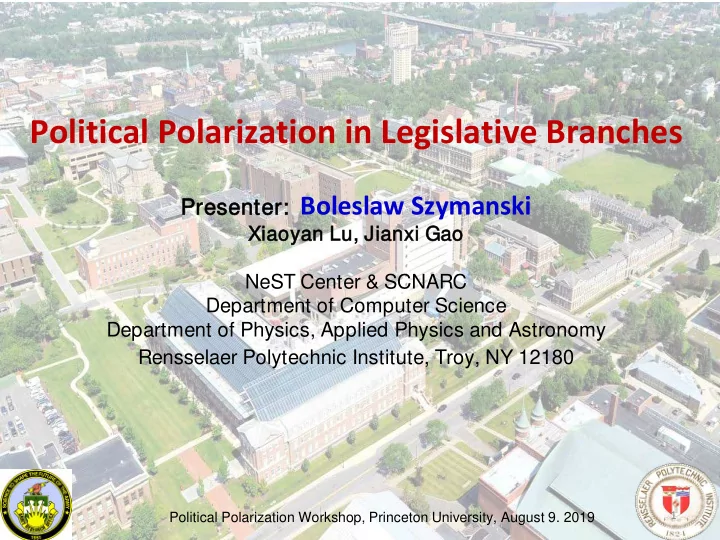

Political Polarization in Legislative Branches er: Boleslaw Szymanski Pres esen enter Xiao aoyan an Lu, Jian anxi Gao ao NeST Center & SCNARC Department of Computer Science Department of Physics, Applied Physics and Astronomy Rensselaer Polytechnic Institute, Troy, NY 12180 1 Political Polarization Workshop, Princeton University, August 9. 2019
2 Introduction ➢ Research objective: How does the social and political polarization evolve over time? ➢ Data-driven analysis: ○ We collect congress/parliament voting data of the countries including Sweden (2.4M votes), UK (3M votes) and USA (3.5M votes) ➢ Quantifying the social choices of competition and collaboration by mathematical models. Political Polarization Workshop, Princeton University, August 9. 2019
3 * Similar results for other countries are in the making Partisan Alignment of Members of the U.S. Congress (2015) Mapping to Partisan alignment measured by the distance between (1+ x-y)/2 parties’ centroids: is member i’s vote on a bill b among the year 2015’s Partisan disagreements bills. ● Relative measure: if one party deviates, then both If all members should move to the poles, but not exactly agree on all bills symmetrically because of the non-uniform population distribution. ● Members’ loyalty to the party does NOT alway lead to polarization. Parties could align with each other on certain bills themselves. ● Mapping to the diagonal, which is equivalent to PCA reducing the dimensions from two to one. Political Polarization Workshop, Princeton University, August 9. 2019
4 Evolution of the Average Partisan Polarization 1900-2018 Monthly 2001-2009 G. W. Bush presidency 1960 Kennedy defeating Nixon 1993-2001 Clinton presidency 1962 Cuban missile crisis 1929 Great Depression 1963 "I Have a Dream" 2009-2017 Obama presidency 1941 Pearl Harbor 1980 Reagan defeating Carter Political Polarization Workshop, Princeton University, August 9. 2019
5 Evolution of the Average Partisan Polarization Polarization increases as a general trend, but it decreases within each congress in the 70s and 80s. Political Polarization Workshop, Princeton University, August 9. 2019
6 Evolution within Each Congress (2 years term) Period I (1969-1989) Polarization decreases Period I Period II Period III Period III ( 2001-2017) Polarization increases (seasonal plot) Political Polarization Workshop, Princeton University, August 9. 2019
7 The evolution of polarization in the legislative branch of government ➢ We analyze millions of roll-call votes cast in the U.S. Congress over the past six decades to identify evolution of political polarization patterns ➢ Using the roll-call vote results, we quantify the level of polarization in the legislative branch of government over the last six decades Political Polarization Workshop, Princeton University, August 9. 2019
8 The evolution of polarization in the legislative branch of government Long-term polarization pattern The political polarization levels at ten evenly - distributed sampled time points exhibit an evolution of polarization patterns from one type of behavior to another
9 Dynamic Social Competition Model [1] measures the current polarization, so the collaboration is measured by the complementary fraction of x, i.e. increased competition lost competition simple symmetric transition functions: Perceived utility of competition, Impact of population = Evolution speed (the benefit fighting against the other belief on the change of party on certain bills) polarization [1] Abrams, D. M., & Strogatz, S. H. (2003). Linguistics: Modelling the dynamics of language death. Nature , 424 (6951), 900. Political Polarization Workshop, Princeton University, August 9. 2019
Recommend
More recommend